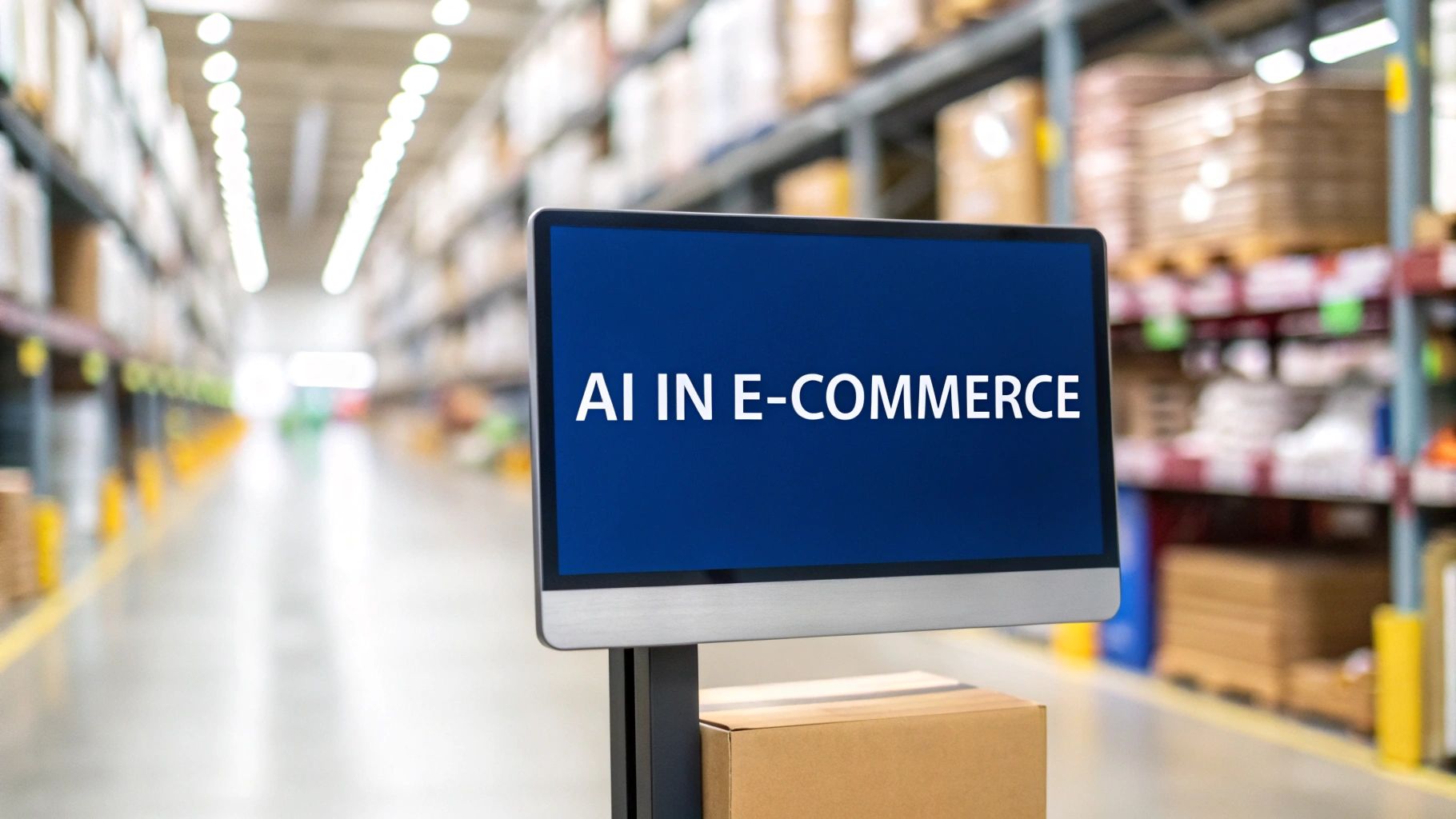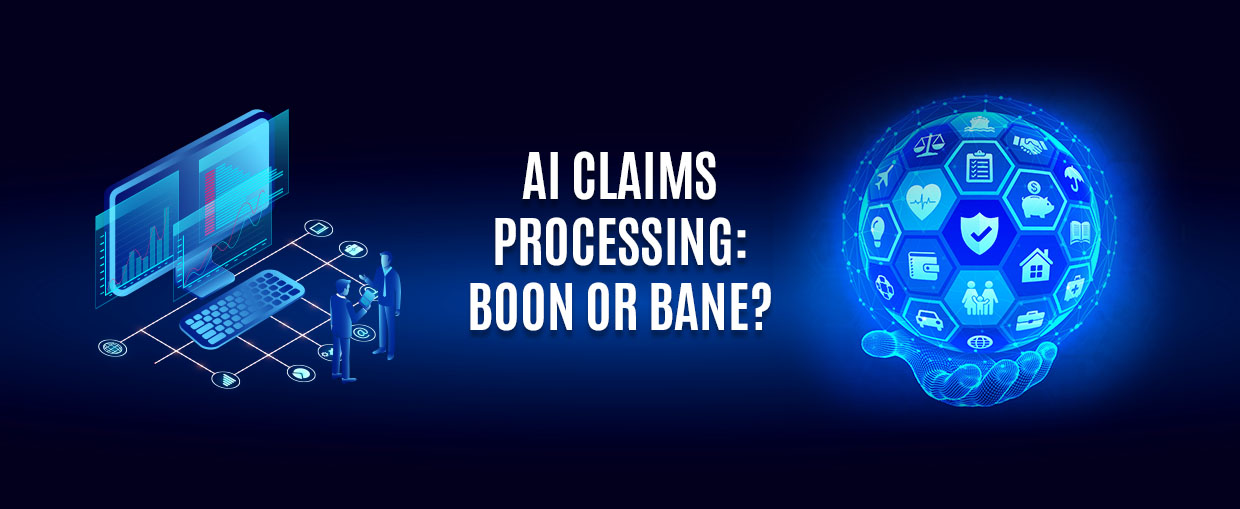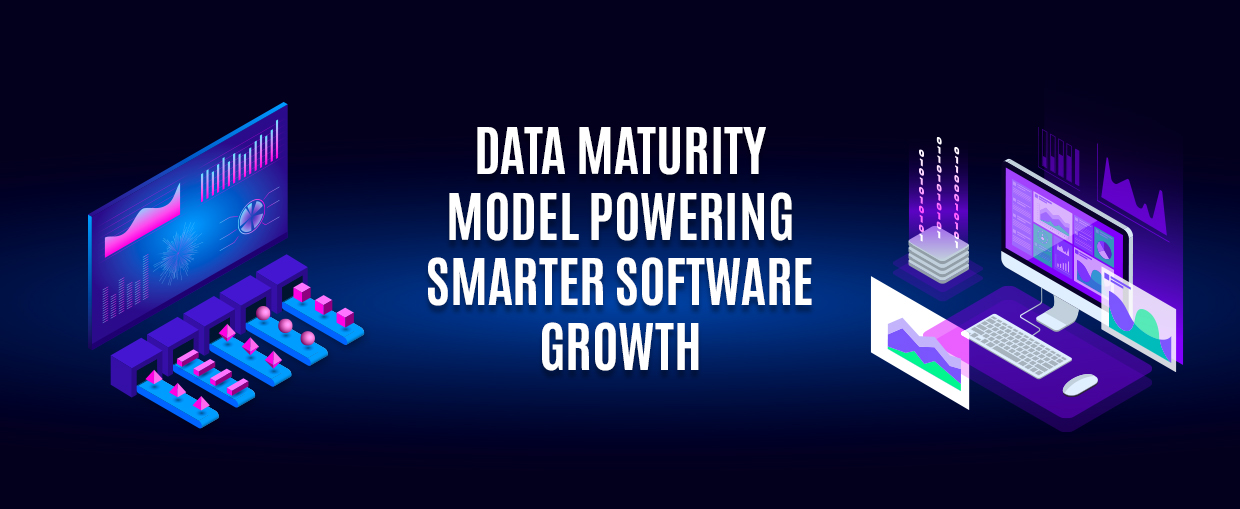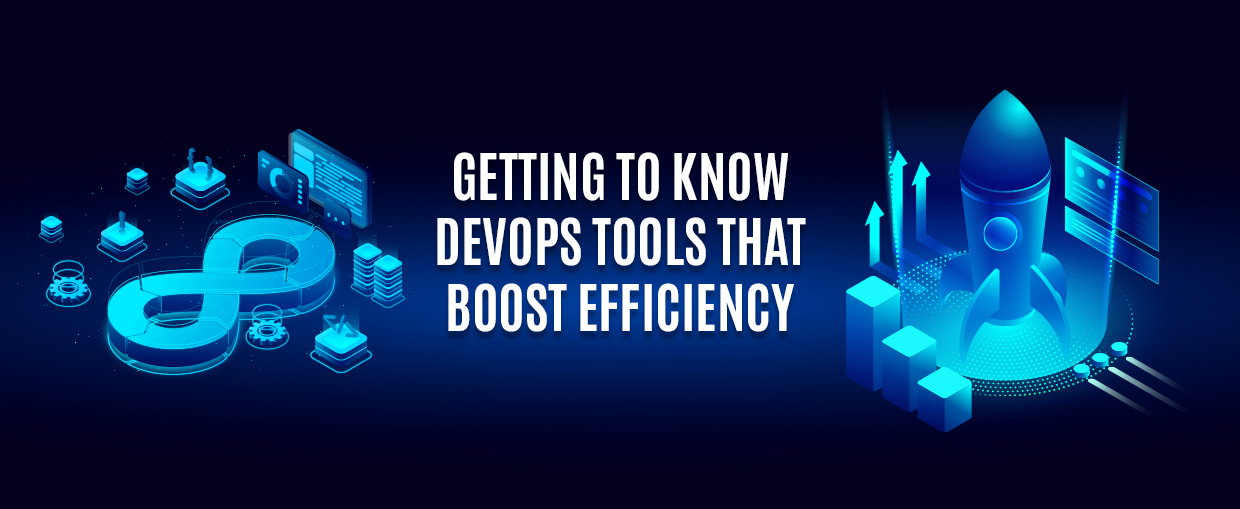The idea of using AI in ecommerce isn't some far-off concept anymore; it's what successful online stores are built on today. It takes a standard digital shop and turns it into a smart, dynamic platform that practically acts as a personal shopper for every single visitor, figuring out what they need and making the path to purchase incredibly smooth.
The New Reality of AI in Ecommerce

Think about a typical online store for a moment. It's often like a static brochure, shows the exact same products and layout to everyone, no matter their personal style or what they've bought before. An AI-powered store, on the other hand, works more like a seasoned sales expert, learning from every click, search, and interaction.
This technology is what allows retailers to go way beyond just listing products. It lets them craft deeply personal shopping experiences on a massive scale, something a human team could never hope to manage. It all comes down to making every customer feel like the store truly gets them.
Why AI Is a Necessity Now
This big push towards AI isn't just happening for the sake of technology. It's a direct response to sky-high customer expectations and the relentless need for efficiency. Today's shoppers want interactions that are fast, relevant, and genuinely helpful. They have no patience for scrolling through pages of items they don't care about; they expect the store to know what they're looking for, sometimes even before they do.
This is exactly where AI shines, bringing real, measurable benefits that hit the bottom line:
Elevated Customer Experiences
AI can offer up tailored product recommendations, deliver smarter search results, and provide 24/7 support. The result? Shopping becomes easier and way more enjoyable.
Smoother Operations
From predicting which products will be popular to automating tedious tasks, AI helps businesses run more efficiently, cutting costs and preventing those dreaded "out of stock" notices.
More Sales and Stronger Loyalty
When you create a better journey and anticipate what your customers need, you naturally see conversion rates climb and people coming back for more.
The adoption numbers in Canada really tell the story here. In the second quarter of 2025, 12.2% of Canadian businesses were already using AI to produce goods or deliver services. That figure more than doubled from just 6.1% in mid-2024, which shows just how quickly these tools are becoming essential for staying in the game.
For a lot of Canadian retailers, AI tools like automated chatbots are the first and most powerful step. They can handle all the routine questions instantly, freeing up human staff to focus on solving the tricky problems that really boost customer satisfaction.
To see just how direct this impact can be, especially for retailers, check out this great resource on AI Chatbots for Retailers. Bringing AI into your business is a core piece of any modern ecommerce strategy.
Creating One-to-One Customer Journeys with AI

If there's one area where AI in ecommerce truly shines, it's in its ability to craft hyper-personalized shopping experiences. We're talking about moving far beyond basic product suggestions to create a unique journey for every single person who lands on your site. This isn't just about showing a customer more of what they've already bought; it’s about anticipating what they'll need next, sometimes before they even know it themselves.
Let’s say a customer is looking for a new pair of winter boots. A standard ecommerce site would probably just show them a grid of similar footwear. An AI-powered store, on the other hand, sees the whole picture.
It watches their clicks, remembers past purchases, and even notes how long they pause on certain styles. Armed with that insight, it can intelligently recommend the perfect wool socks to go with the boots, a can of waterproof spray, and maybe even surface a blog post about the best local winter hiking trails. That's the core of AI-driven personalization: turning a simple transaction into a genuinely helpful, tailored experience.
How AI Actually Delivers This Personal Touch
So, what's happening behind the curtain? AI systems sift through enormous piles of customer data, such as every search, click, and purchase, and feed it into sophisticated data-filtering tools. These tools use complex algorithms to predict what each individual will find most relevant and compelling.
This process unlocks several powerful personalization tactics:
Dynamic Product Recommendations
Forget static "You May Also Like" carousels. AI curates suggestions based on what a user is doing right now. Someone looking at running shoes might see recommendations for moisture-wicking socks or a running belt, not just more shoes.
Personalized Website Layouts
The entire feel of your homepage can adapt on the fly. AI can push a user's favourite categories to the forefront or highlight promotions on brands they've bought from before.
Tailored Email Campaigns
This is where you can make marketing feel like a one-on-one conversation. AI can trigger emails for an abandoned cart, send an alert when a wish-listed item goes on sale, or suggest accessories for a product they just bought.
This level of personal attention really pays off. Retailers who get this right often see a 40% increase in revenue. It's a massive opportunity, especially when you consider that only about one in ten retailers are currently implementing this kind of deep personalization across all their channels.
By understanding and predicting what customers need, AI builds relationships. Every interaction feels more relevant and helpful, creating a sense of loyalty that generic marketing simply can't compete with.
From Smarter Searches to Dynamic Pricing
Beyond recommendations, AI also refines the fundamental features of an online store. One of the most important is site search. Nothing sends a potential customer packing faster than a search that returns irrelevant results. It’s no surprise the average ecommerce bounce rate hovers between 20-45%.
AI-powered search understands what a user means, not just what they type. For example, if someone searches for "dresses" in May after previously buying items for a beach vacation, the AI can infer they're probably looking for summer styles and prioritize sundresses over formal evening wear. This kind of intuitive understanding removes friction and gets shoppers to what they want faster.
Another powerful application is dynamic pricing. AI algorithms can analyze market demand, competitor pricing, and even a customer's own browsing history to adjust prices in real time. This lets you stay competitive and maximize revenue without needing someone to manually track everything, all the time.
For instance, a hot-ticket item might see a tiny price bump during peak demand, while a product that a specific user has viewed multiple times but never bought could be offered with a small, personal discount to nudge them toward a purchase.
These strategies work together to create a smarter, more responsive shopping environment. If you want to explore this further, you can learn more about how AI in retail is redefining the shopping experience and building these one-to-one connections. It all adds up to a personal touch that drives sales and keeps your customers coming back.
Building a Predictive Supply Chain with AI
While personalized recommendations are what customers see on the front end of your store, AI is also quietly revolutionizing things behind the scenes. It's working on the operational backbone of your business, transforming supply chain management from a reactive, often stressful, process into a predictive science. The goal? To have the right products, in the right place, at precisely the right time.
For years, inventory management has been a game of looking in the rearview mirror, basing decisions on historical sales data and, frankly, a bit of guesswork. This old-school approach almost always leads to two very expensive problems: frustrating stockouts on your bestsellers and warehouses full of overstocked items nobody wants. AI completely flips this script by bringing intelligent demand forecasting into the picture.
This is where AI gets really powerful, integrating with warehouse operations to create a smarter, more efficient system.

You can almost visualize the flow of data informing every decision, from real-time stock levels all the way to delivery logistics.
Moving From Guesswork to Prediction
AI-powered forecasting models look at a massive number of data points, going way beyond simple sales history. These systems can crunch information from all sorts of sources to build a remarkably accurate picture of what's coming next.
What kind of data are we talking about?
Historical Sales Data: Of course, it starts here, identifying long-term patterns and how products perform over time.
Market Trends: It keeps an eye on social media buzz, industry news, and what competitors are up to, spotting emerging crazes before they hit the mainstream.
External Factors: This is the clever part. AI analyzes variables like upcoming holidays, local events, and even weather forecasts that can sway buying behaviour.
Think of it this way: an AI system might see an early cold snap predicted for Western Canada and automatically bump up the stock forecast for winter coats in that region. You’re preventing stockouts before the demand even spikes, ensuring customers find what they need and you don't miss out on sales.
By using predictive analytics, businesses can seriously cut their inventory costs and improve service levels at the same time. The supply chain becomes so efficient it's almost invisible to the customer, products are just there when they want them.
Optimizing Warehouse and Delivery Logistics
AI's impact doesn't stop at forecasting. It also brings a new level of efficiency to how your warehouse runs and how you get products to your customers. Inside the warehouse, AI can automate replenishment orders, ensuring you restock before levels get critical. It's a proactive approach that minimizes human error and keeps the whole system humming along.
The table below breaks down the key differences between the old way of doing things and the new, AI-powered approach.
Comparing Traditional vs AI-Powered Inventory Management
This table highlights the key differences and advantages of integrating AI into inventory and supply chain processes compared to conventional methods.
Feature | Traditional Method | AI-Powered Method |
|---|---|---|
Demand Forecasting | Relies on historical sales and manual analysis | Uses predictive analytics, market trends, and external factors for high accuracy. |
Stock Replenishment | Manual reordering based on set thresholds. | Automates purchase orders based on real-time data and predicted demand. |
Error Handling | Reactive; identifies issues after they occur. | Proactive; predicts potential stockouts or overstocks to prevent them. |
Route Optimization | Fixed routes, often inefficient. | Dynamically optimizes delivery routes based on traffic, weather, and destinations. |
Overall Efficiency | Prone to costly overstock/stockout situations. | Minimizes waste, lowers holding costs, and improves customer satisfaction. |
As you can see, the shift is from a reactive stance to a proactive one, which makes all the difference in a competitive market.
Furthermore, AI algorithms are brilliant at optimizing delivery routes. By analyzing traffic patterns, delivery destinations, and vehicle capacity, these systems plot the most efficient path for every shipment. This doesn't just mean faster delivery times; it also cuts down on fuel costs and reduces your operation's carbon footprint. The benefits of using AI in supply chain and logistics operations are clear, leading to faster fulfilment and happier customers.
This kind of operational efficiency is becoming absolutely critical. With Canada's ecommerce market projected to make up 13.0% of all retail sales in 2025, the pressure is on. This growth is heavily influenced by AI technologies that improve both the customer experience and the back-end capacity to handle a higher volume of orders. Even though sectors like grocery are expected to contribute over 22% of Canada's ecommerce sales growth between 2025 and 2029, a trend largely powered by these digital advancements. You can find more details in these Canadian ecommerce statistics from aftership.com.
Enhancing Support with AI-Powered Assistants
Beyond tweaking product recommendations and sorting out the supply chain, AI is completely overhauling how ecommerce stores handle customer support. It's turning what was once a reactive cost centre into a proactive way to build real customer loyalty. Forget the days of endless hold music and frustrating phone menus; we're moving into an era of instant, smart, and always-available help.
Leading this charge are AI-powered chatbots and virtual assistants. Picture them as your store's most dedicated employee, ie, one who never needs a coffee break and can chat with thousands of customers at once. They offer immediate, 24/7 support for all those common questions that used to tie up your human support agents.
This instant response is a huge deal. Customers no longer have to wait until Monday morning to ask simple things like, "Where is my order?" or "What's your return policy?" An AI assistant can pull up order details and sift through your knowledge base in a heartbeat to give a clear, accurate answer.
More Than Just a Scripted Response
Today's AI assistants are miles ahead of the clunky, script-based bots from a few years ago. These systems use natural language processing (NLP) to understand what a customer actually means, not just the specific words they type. They can make sense of complex questions, look at a customer's order history for context, and offer genuinely helpful support.
So, when a customer asks, "My last order hasn't arrived, what's up?", the AI doesn't just spit out a generic tracking link. It can pinpoint the exact order, check its live shipping status, and give a detailed update in a matter of seconds.
This level of intelligence means most routine issues get solved right away. In fact, AI-powered chatbots now handle roughly 70% of online customer conversations, which shows you just how essential they've become. For the trickier problems, they serve as a smart first stop.
The real power of AI in customer support isn't about replacing humans; it's about augmenting them. By handling routine tasks, AI frees up your skilled human agents to focus on high-value, complex problems that require empathy and critical thinking.
Creating a Seamless Support Ecosystem
One of the smartest things an AI assistant does is figure out when to hand a problem off to a person. When a question is too complex, it doesn't just throw up its hands. Instead, it smoothly transfers the conversation to a human agent, along with the entire chat history for context.
This simple handoff gets rid of one of the biggest customer service headaches: having to explain your problem over and over again. The human agent can jump right in where the AI left off, completely up to speed and ready to solve the issue. This creates an efficient support experience that keeps customers happy and gets problems solved faster. To take this a step further, exploring personalized chatbot solutions can deliver even more tailored, context-aware support that really feels like your brand.
Here’s how this streamlined workflow directly helps your ecommerce business:
Improved Efficiency: Your support team isn't bogged down with repetitive questions, freeing them up for tasks that truly matter.
Increased Customer Satisfaction: Shoppers get instant answers for easy questions and a much faster, more informed response for the tough ones.
Cost Reduction: Automating a huge chunk of your support inquiries can lead to serious operational savings. In fact, research shows that adopting AI can lead to more than a 25% improvement in customer satisfaction or cost reduction.
At the end of the day, bringing AI assistants into your support strategy is about making things better for everyone. Your customers feel heard and looked after, and your team is empowered to do their best work. That's how great service becomes a real competitive edge.
Driving Smarter Sales with AI Marketing
Beyond simply tweaking what a customer sees on your website, AI has become a secret weapon for marketing and sales teams. It has an incredible ability to sift through mountains of customer data, spotting patterns and connections that a human team could never find. This allows for a level of advertising precision that was once pure science fiction.
Essentially, you can finally move away from the old "spray and pray" method of advertising and start having direct, relevant conversations with your ideal customers.
Think of AI as a master detective on your marketing staff. It looks at everything, such as past purchases, browsing habits, and demographic details, to build incredibly detailed profiles of your different customer segments. This doesn't just tell you who your customers are; it points you directly to your most valuable ones.
Armed with that knowledge, you can start aiming your ad spend with surgical accuracy. AI models can even predict which users are most likely to buy, helping you put your budget where it will have the biggest impact and generate a much healthier return.
Targeting the Right Audience at the Right Time
One of the most powerful ways AI is changing ecommerce marketing is through predictive targeting. Instead of just retargeting every single person who visited your site, AI can zero in on visitors who showed clear signs of wanting to buy, like those who spent ages on a product page or added several items to their cart. This lets you serve up a perfectly timed, relevant ad that nudges them over the finish line.
This whole process works by blending different types of data to get a 360-degree view of each shopper:
Behavioural Data: It tracks all the digital footprints, like clicks, pages viewed, time spent on your site, and what’s happening in their shopping cart.
Transactional History: It looks at what they've bought before to get a sense of the brands they like and how much they're willing to spend.
Demographic Information: It uses things like location to tailor promotions and messaging that will actually resonate.
By weaving these insights together, AI helps you create campaigns that feel less like an intrusive ad and more like a genuinely helpful suggestion. This precision doesn't just boost conversion rates; it also prevents people from getting tired of your ads. If you’re looking for practical ways to implement this, there are many strategies to increase online sales with AI and automation you can explore.
AI marketing tools don't just find customers; they find the right customers. This shift from volume to value is key to building a sustainable and profitable ecommerce business.
The Rise of AI-Driven Social Commerce
This intelligent targeting becomes a real game-changer in the world of social commerce, which is a massive force in Canadian retail. The personalized product feeds and dynamic ads you see on platforms like Instagram, TikTok, and Facebook are all powered by AI algorithms, creating a fluid journey from discovery to checkout.
The Canadian ecommerce scene in 2025 is increasingly shaped by these AI-enhanced strategies, which are tightly woven into mobile and social trends. Mobile commerce is huge here, with over 64.9% of Canadian smartphone users using mobile wallets for payments. This opens the door for smooth, AI-powered shopping solutions right on their phones. Social platforms are now major sales channels in Canada, where AI analyzes user behaviour to push customized product suggestions and dynamic ads, making the entire buying process frictionless.
This blend of AI and social media creates a powerful flywheel. The more a user interacts with content, the better the AI gets at understanding what they like, which in turn leads to even better recommendations. For your business, this means your products are being put in front of an audience that is already warmed up and highly receptive. It’s a far smarter way to advertise, maximizing your reach and driving sales directly from the platforms where your customers are already spending their time. Getting this level of targeting right is fundamental to a modern sales strategy. For a deeper dive, check out the ultimate guide to ecommerce personalization.
Frequently Asked Questions About AI in Ecommerce
Thinking about bringing AI into your ecommerce business can spark a lot of questions, especially for Canadian entrepreneurs wondering where to even begin. We’ve broken down some of the most common concerns with practical, straightforward answers to help you see how these tools can really work for you.
Can Small Canadian Businesses Actually Afford AI Tools?
Absolutely. One of the biggest myths floating around is that AI is just for giant corporations with bottomless budgets. The truth is, the explosion of user-friendly apps and plugins on platforms like Shopify and WooCommerce has put powerful AI tools within reach for businesses of any size.
You don't need a massive upfront investment. Instead, you can start small with a tool that solves one specific problem. Think about adding a product recommendation engine or a customer service chatbot; many of these operate on a simple, manageable monthly fee. The trick is to identify a clear pain point, like high cart abandonment or slow customer support, and find an affordable AI solution built to fix it.
This targeted approach lets you see a tangible return on your investment through more sales or better efficiency, without breaking the bank.
What Is the Best First Step to Start Using AI?
The best first move has nothing to do with buying fancy software. It's all about your data. Before you do anything else, make sure you have a good system for collecting information on your customers and sales. This is the fuel that makes any AI system run.
Once you have a handle on your data, pick a single, clear goal you want to achieve.
Want to increase your average order value? Start with an AI personalization tool that suggests relevant add-ons at checkout.
Need to boost customer satisfaction? An AI chatbot is a fantastic, cost-effective place to start.
Struggling with stockouts? Look into a simple AI-powered tool for demand forecasting.
The key is not to try and do everything at once. Kicking off with one manageable project lets you measure its impact, learn as you go, and build momentum for the future. It's a methodical way to ensure you get real value right from the start.
Will Using AI Make My Brand Feel Cold and Robotic?
This is a really common fear, but when it’s done right, AI does the exact opposite. It helps you personalize customer interactions at a scale that would be impossible for a human team to manage. The point isn’t to replace the human touch, but to amplify it.
AI does the heavy lifting, analyzing data to suggest products a customer will genuinely love, which makes them feel seen and understood. It can also provide instant answers to simple questions 24/7, a level of convenience that modern shoppers really value.
The real magic happens when AI frees up your team from repetitive tasks so they can provide thoughtful, empathetic support for more complex issues. The key is to use AI to make things smoother while always keeping your brand’s unique voice and offering an easy way to reach a human when needed.
This strategy actually strengthens your brand by making it more responsive and helpful, not less personal. The human touch is saved for the moments it matters most.
What Kind of Data Do I Need for AI to Work?
You don't need a perfect, massive database to get going. Most AI tools can deliver impressive results with the kind of data your ecommerce platform is probably already collecting.
The essentials usually fall into three main buckets:
Transactional Data: This is the basic "what, when, and how much" of every purchase. It’s the foundation for understanding what people are buying.
Behavioural Data: This covers how shoppers interact with your site the pages they browse, the products they click on, and what they add to their cart. It gives you incredible insight into what they intend to do.
Customer Data: Basic info like a customer's location and their overall purchase history helps you create more relevant, tailored experiences.
Even just a few months of this information is often enough for many AI tools to start spotting patterns and delivering value. The system will keep learning and get smarter over time, so the sooner you start collecting good data, the better.
How Do I Choose the Right AI Tool?
With so many options out there, picking the right tool can feel overwhelming. A simple framework can help. First, pinpoint your single biggest business challenge right now. Is it converting more visitors into buyers? Keeping your existing customers engaged? Or is it getting a better handle on your inventory?
Once you have that clear objective, you can look for tools specifically designed to solve that problem. Read reviews, check out case studies from businesses like yours, and always take advantage of free trials. A good AI tool should integrate smoothly with your existing ecommerce platform and give you clear analytics to track its performance.
Don’t get dazzled by a long list of complex features you'll never use. Often, the best tool is the one that does one thing exceptionally well and delivers a measurable return. Start small, prove its value, and then you can expand your AI toolkit as your business grows.
At Cleffex Digital ltd, we specialize in building innovative software solutions that solve real-world business challenges. If you're ready to explore how AI can elevate your ecommerce business, visit us to learn how our custom development services can help you grow.









